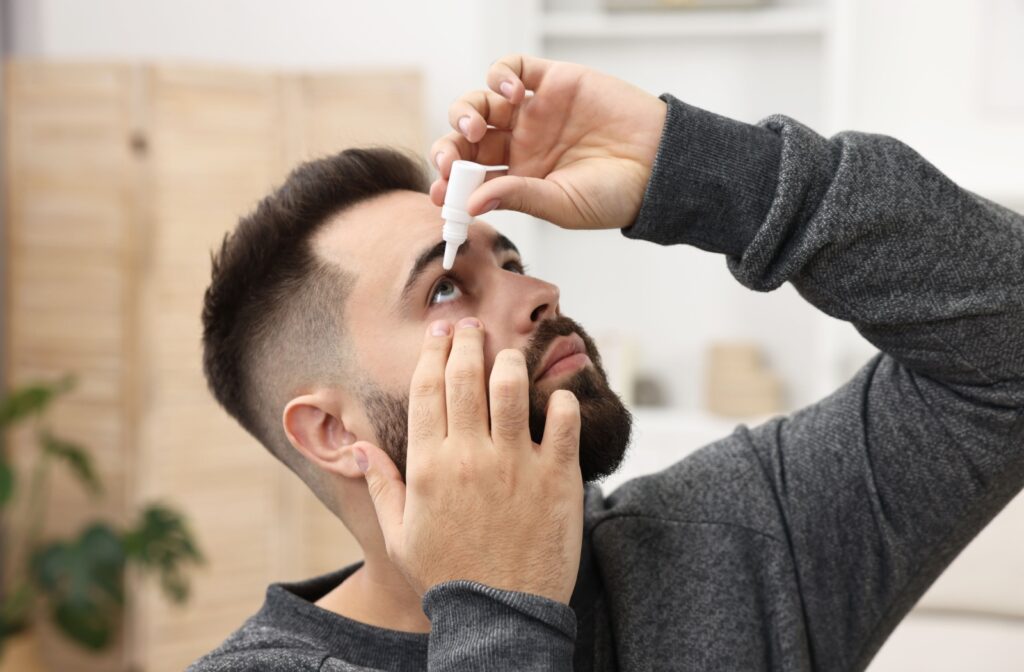Imagine trying to read your favourite book, but the words keep slipping in and out of focus—frustrating, right? This could be a sign of dry eye syndrome affecting your vision.
When your eyes don’t produce the proper lubricating tears, it can create an uneven or irregular eye surface, leading to blurry or fluctuating vision.
If you’ve been dealing with dry eyes, getting to the root cause can help prevent worsening discomfort. Booking an eye exam is the first step to determine whether your blurry vision is because of dry eyes or another concern.
How Does Dry Eye Syndrome Affect Your Vision?
Dry eye syndrome happens when your eyes either don’t produce the proper lubricating tears or the tears evaporate too quickly.
Tears are essential for keeping your eyes lubricated and for maintaining a smooth surface on the front of your eye. This tear film acts as a clear layer that helps focus light properly.
When your tear film is disrupted, your vision can become blurry. Think of it like looking through a dirty or unevenly fogged-up window. Key symptoms of dry eye syndrome include:
- A stinging or burning sensation
- Redness or irritation
- Sensitivity to light
- A gritty or sandy feeling in the eye
Can Dry Eyes Cause Blurred Vision?
Blurred vision is a common symptom of dry eye syndrome.
When your eyes lack sufficient tear coverage, the cornea (the eye’s clear front surface) may become uneven. Since light requires a smooth surface to focus properly on your retina, this irregularity disrupts the process, resulting in blurry or fluctuating vision.
Blurred vision from dry eyes is usually temporary and can improve after blinking, applying artificial tears, or resting your eyes. However, if chronic dry eye remains untreated, it can result in longer-lasting visual complications if the surface becomes irritated or scarred.
Common Causes of Dry Eye Syndrome
Dry eye symptoms can be caused by a combination of individual contributing factors.
1. Environmental Factors
Windy conditions, dry climates, or low indoor humidity can increase tear evaporation, leading to dry eyes.
2. Prolonged Screen Use
If you spend hours staring at a screen, you may blink less often, which can reduce tear distribution and speed up evaporation.
3. Age & Hormonal Changes
Our ability to produce adequate tears often decreases as we age. People over 50, especially women undergoing hormonal changes, are at higher risk.
4. Medications or Medical Conditions
Certain medications, including antihistamines, antidepressants, and blood pressure drugs, may contribute to dry eye symptoms.
Certain chronic health conditions, including diabetes, rheumatoid arthritis, and Sjögren’s syndrome, are often associated with dry eye.
5. Contact Lenses
Contact lenses can absorb moisture from your eyes and intensify dry eye symptoms. By identifying the underlying cause of your dry eyes, your eye doctor can help you find effective treatments and enhance your comfort while wearing contact lenses.
Managing Dry Eye Symptoms for Clearer Vision
The good news is that you can manage dry eye symptoms with the appropriate approach. By thoroughly understanding your unique contributing factors, your eye doctor can help you alleviate your symptoms and prevent blurred vision caused by dryness.

1. Use Artificial Tears or Lubricating Drops
Over-the-counter artificial tears are often the first line of defence to help replenish moisture and stabilize your tear film. Look for preservative-free options for regular use.
2. Follow the 20-20-20 Rule
Prevent screen-induced dry eye by following the 20-20-20 rule. Every 20 minutes, take a 20-second break and look at something 20 feet away to encourage proper blinking.
3. Increase Indoor Humidity
Using a humidifier at home or in the office can prevent your tears from evaporating too quickly by adding moisture back into the air.
4. Stay Hydrated
Drinking plenty of water helps keep your body and your eyes hydrated. How much you need depends on your unique needs, environment, and activity level, but adults generally benefit from 11.5 cups to 15.5 cups per day.
5. Upgrade Your Eye Care Tools
Consider protective measures like anti-glare computer glasses, warm eye compresses, or even eyelid cleansers, particularly if meibomian gland dysfunction (MGD) is a contributing factor.
When to See an Eye Doctor About Blurry Vision
Home remedies can help with temporary or mild dry eye symptoms. However, if blurry vision or other symptoms persist, consult a professional. We can help identify the underlying cause and provide targeted treatments, like prescription eye drops, to manage chronic dry eye.
Blurred vision may also indicate other health or eye conditions like glaucoma, cataracts, or diabetic retinopathy, which can be managed more effectively when diagnosed early.
At EyeCare Niagara, our experienced team can assess your symptoms, determine the root cause, and develop a tailored treatment plan to address your unique eye care needs. Dry eyes don’t have to be a constant struggle. Book an appointment with EyeCare Niagara and take the first step toward clearer, healthier eyes.




